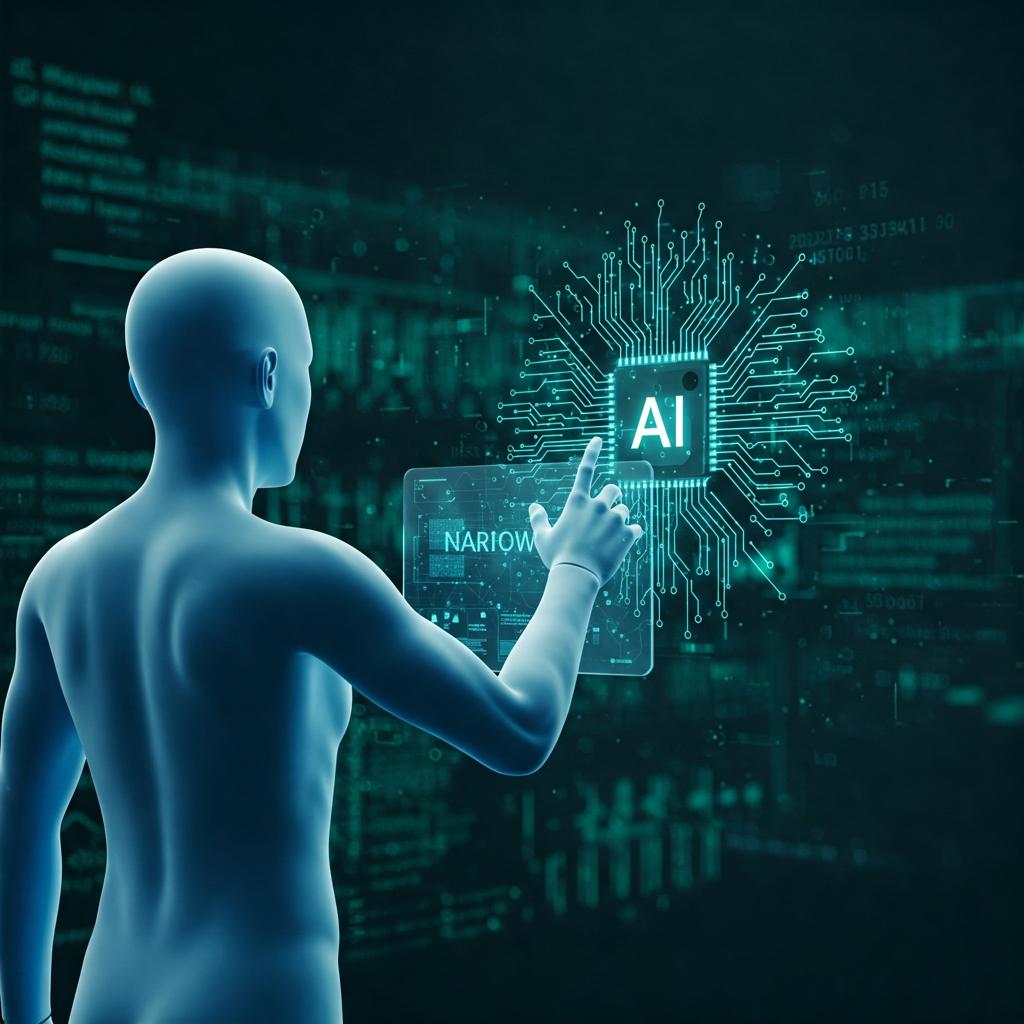
Weak AI: The Focused Intelligence in Action
Narrow AI, often referred to as Weak AI, is the most prevalent and widely used form of artificial intelligence in modern technology.
Unlike General AI, which aspires to possess the comprehensive cognitive abilities of a human being across a wide range of tasks, Narrow AI is purpose-built to perform a specific task or a limited set of tasks. This targeted functionality is what makes Narrow AI so powerful in real-world applications. From voice assistants to fraud detection, Narrow AI is quietly but profoundly transforming the way industries operate and how individuals interact with technology on a daily basis.
In this comprehensive guide, we explore what Narrow AI is, its defining features, how it works, real-world examples across industries, its advantages, limitations, and what the future holds for this powerful but focused subset of artificial intelligence.
What is Narrow AI?
Narrow AI, or Weak AI, refers to artificial intelligence systems that are highly specialized. These systems are engineered to carry out a particular function, often with great precision and reliability. They do not possess general reasoning abilities and are not capable of independent thought or problem-solving beyond their narrowly defined domain.
These systems are not conscious, self-aware, or emotionally intelligent. Instead, they excel at pattern recognition, automation, data analysis, and repetitive tasks. They function based on algorithms and datasets that are curated and trained to enable them to perform a task efficiently and consistently.
The term "narrow" is not a limitation in itself but rather a reflection of the system’s focused scope. This singular focus often enables these systems to outperform humans in specific tasks, such as image recognition or playing a strategic board game.
Key Characteristics of Narrow AI
Understanding the core attributes of Narrow AI helps differentiate it from other branches of artificial intelligence, particularly Artificial General Intelligence (AGI) and Artificial Superintelligence (ASI). The defining characteristics include:
1. Task-Specific Functionality
Narrow AI systems are created with a singular task in mind. Whether it’s facial recognition, language translation, or product recommendation, each system is restricted to performing a particular function and cannot adapt to perform unrelated tasks without reprogramming.
2. High Accuracy Within Scope
Because Narrow AI is trained for a specific use case, it often performs that task with remarkable accuracy. For example, AI-powered diagnostic tools in radiology can detect abnormalities in medical imaging with extremely high precision.
3. Lack of Sentience or Consciousness
Narrow AI does not "understand" tasks in the human sense. It has no self-awareness, emotions, or cognitive faculties. It processes inputs and delivers outputs based on algorithmic training rather than conscious thought.
4. Data-Dependent Performance
The effectiveness of Narrow AI depends heavily on the quality and quantity of the data it is trained on. High-quality datasets lead to better performance, while biased or incomplete data can result in errors and unintended consequences.
5. Non-Adaptable Without Retraining
Unlike humans who can apply knowledge flexibly across different contexts, Narrow AI must be explicitly retrained or re-engineered to perform new tasks. It lacks the ability to generalize learning from one domain to another.
How Narrow AI Works
Narrow AI functions through a combination of machine learning algorithms, data processing, and task-specific programming. The development pipeline typically involves the following stages:
Data Collection and Labeling
To train a Narrow AI system, vast amounts of labeled data are gathered. This data serves as the foundation for learning patterns and correlations within a specific domain.
Model Training
Machine learning models—especially deep learning neural networks—are used to analyze the training data. These models learn to recognize patterns, predict outcomes, or make decisions based on statistical probabilities.
Task-Specific Optimization
Once the model reaches an acceptable level of performance, it is further optimized to enhance efficiency, reduce latency, and tailor it for real-world use cases.
Deployment and Feedback Loop
The trained model is deployed into an application, and real-world data continues to feed the system. In some cases, continual learning or retraining is implemented to improve accuracy over time.
Real-World Applications of Narrow AI
The versatility of Narrow AI can be observed across nearly every sector. Here are some prominent examples of how Narrow AI is transforming industries today:
1. Voice-Activated Virtual Assistants
Apple’s Siri, Amazon’s Alexa, and Google Assistant are prime examples of Narrow AI in action. These assistants use natural language processing (NLP) to understand and respond to voice commands. They can manage calendars, answer questions, play music, and control smart devices. However, they are confined to predefined tasks and cannot understand or perform actions outside their programmed capabilities.
2. Recommendation Engines
Companies like Netflix, Amazon, and YouTube use Narrow AI to analyze user behavior and preferences. These recommendation systems process data on viewing habits, purchase history, and user ratings to suggest content that aligns with individual tastes. The success of these systems lies in their ability to personalize user experiences, thereby increasing engagement and sales.
3. Autonomous Driving Technologies
Self-driving cars, developed by companies such as Tesla and Waymo, rely heavily on Narrow AI. These systems interpret data from cameras, LIDAR, GPS, and other sensors to make real-time driving decisions. While impressive, they are still limited to specific driving environments and require human oversight in complex scenarios.
4. AI in Healthcare Diagnostics
Narrow AI is revolutionizing healthcare by aiding in the early detection of diseases. AI algorithms can now analyze radiological scans, pathology slides, and genetic data with a level of accuracy that rivals or even surpasses human professionals. These tools are being used to detect cancer, diabetic retinopathy, and other conditions with remarkable success.
5. Fraud Detection Systems
Financial institutions use Narrow AI to detect fraudulent transactions. These systems analyze vast numbers of transactions in real-time, flagging those that deviate from typical patterns. Machine learning models are trained on historical fraud data to improve accuracy over time.
6. Facial Recognition Technology
From unlocking smartphones to security surveillance, facial recognition systems are classic examples of Narrow AI. These systems compare captured images with stored data to verify identity or detect matches. While highly accurate, they are only effective within the narrow task of facial analysis.
7. Customer Service Chatbots
Narrow AI powers chatbots used in customer service. These bots can handle FAQs, process returns, or troubleshoot basic technical issues. They are trained on a specific dataset related to company policies and products and lack the ability to respond effectively to complex or unusual queries.
Advantages of Narrow AI in Industry
Despite its limited scope, Narrow AI brings numerous benefits that make it an indispensable tool for modern enterprises and daily life.
1. Enhanced Operational Efficiency
By automating repetitive and time-consuming tasks, Narrow AI helps organizations improve productivity and reduce human error. This results in faster processes and cost savings.
2. Scalability
Once deployed, Narrow AI systems can handle large volumes of data or user interactions without fatigue, making them ideal for applications that require high scalability.
3. High Precision
In fields like medicine and finance, the ability of Narrow AI to detect subtle anomalies can lead to better outcomes, whether it’s spotting a tumor in a scan or flagging a suspicious transaction.
4. Continuous Availability
Unlike human employees, AI systems can work around the clock, providing uninterrupted service and monitoring, which is particularly useful in sectors such as security, healthcare, and customer support.
5. Improved User Experience
Personalization engines powered by Narrow AI enhance the customer journey, from personalized shopping suggestions to tailored content, making user engagement more effective and satisfying.
Limitations and Challenges of Narrow AI
While Narrow AI is incredibly powerful within its domain, it also faces notable limitations and challenges:
1. Lack of General Intelligence
The biggest drawback of Narrow AI is its inability to think beyond its programming. It cannot adapt or transfer knowledge between different tasks, limiting its utility in dynamic environments.
2. Bias and Ethical Concerns
Because Narrow AI relies heavily on historical data, it can inherit and amplify biases present in that data. This can lead to unfair treatment or discrimination, especially in sensitive applications like hiring, law enforcement, or credit scoring.
3. Dependency on Data Quality
Poor data quality leads to poor outcomes. Narrow AI systems are only as good as the data they are trained on. Incomplete, inaccurate, or biased data can skew results and reduce reliability.
4. Security Vulnerabilities
AI models can be susceptible to adversarial attacks where small, deliberate modifications in input data can mislead the system. In security-critical applications, this can pose serious risks.
5. Lack of Contextual Understanding
Narrow AI lacks the ability to understand the broader context or the "why" behind data. For instance, a language model might generate grammatically correct responses that are contextually irrelevant or nonsensical.
The Future of Narrow AI
The evolution of Narrow AI is far from over. Advancements in areas such as transfer learning, federated learning, and edge computing are continuously expanding the capabilities of Narrow AI systems. Future iterations are expected to be more robust, context-aware, and adaptable—though still confined to specific tasks.
Industries such as healthcare, education, logistics, agriculture, and manufacturing are poised to benefit further as Narrow AI becomes increasingly integrated into core operations. Simultaneously, the rise of AI ethics and regulatory frameworks will shape how these technologies are deployed responsibly and equitably.
While General AI remains a long way off, Narrow AI will continue to lead the way in practical, real-world applications for the foreseeable future. The next wave of Narrow AI will likely focus on enhancing its efficiency, reducing biases, and enabling greater adaptability within its designated tasks.
1. Improvements in Learning Efficiency
Advancements in machine learning techniques like transfer learning and meta-learning may enable Narrow AI systems to learn more efficiently from smaller datasets. This could result in quicker adaptation to new tasks without requiring massive datasets or significant retraining. As a result, AI systems will become more versatile within their narrow domains, reducing the reliance on enormous volumes of training data.
2. Greater Integration with Internet of Things (IoT)
The proliferation of IoT devices is expected to further expand the applications of Narrow AI. As connected devices generate increasing amounts of data, AI will be used to process this information in real-time, enabling better automation and decision-making. For example, AI could help optimize traffic flow, predict maintenance for machinery, or enhance home automation systems.
3. Cross-Industry Applications
While Narrow AI is currently seen in many industries like healthcare, finance, and retail, its future will see deeper integration into new sectors. Industries like agriculture will benefit from AI-driven tools for crop monitoring and precision farming. Logistics will also see major improvements with AI managing supply chains and optimizing delivery routes more efficiently. The potential for Narrow AI to support diverse fields is limitless as its applications continue to grow.
4. Focus on Ethical AI
As Narrow AI permeates various aspects of society, there will be increased emphasis on addressing ethical concerns. This includes improving transparency in decision-making processes, mitigating algorithmic biases, and ensuring fairness in automated decisions. Efforts will be made to ensure that AI is implemented responsibly, especially in areas like hiring, law enforcement, and healthcare where biased outcomes could have serious consequences.
5. AI-Driven Personalization
The power of Narrow AI in personalizing experiences will only increase as algorithms become more sophisticated. The future will see even more tailored customer experiences across e-commerce platforms, content recommendations, and healthcare services. AI’s ability to predict customer preferences and make proactive recommendations will revolutionize industries focused on user engagement and satisfaction.
6. AI as a Service (AIaaS)
AI as a Service is already gaining momentum, where organizations can access AI tools and algorithms without having to develop their own complex models. In the future, businesses will be able to leverage Narrow AI solutions on-demand for various specialized functions, such as customer support, marketing automation, and predictive maintenance. This shift will make advanced AI accessible to smaller businesses and startups that previously lacked the resources to develop such systems in-house.









